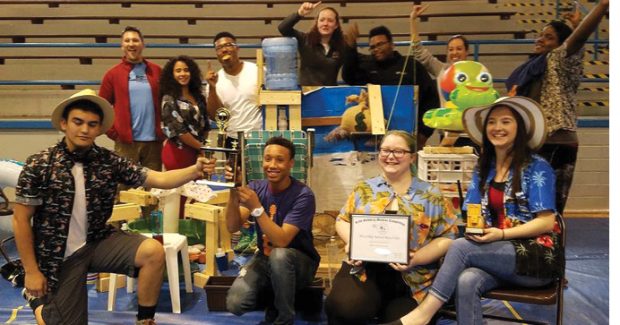Hands-on Machine Engineering

Rube Goldberg Machine Contest participants pose with their machines. Image courtesy of RGI.
Latest News
December 1, 2017
For the past 30 years, elementary school students have been exercising their innovative passions in a competition whose moniker is the name of a person and has become an expression in the context of creating a complicated solution to a problem.
Kathleen Felix is the executive director of Rube Goldberg, Inc. (RGI). We spoke to her for an overview of the Rube Goldberg Machine Contest (RGMC).
Kathleen Felix: 2018 is the 30th anniversary of the RGMC. The RGMC is an event where students from elementary school through university compete with Rube Goldberg Machines they have imagined, designed and created in a fun and competitive forum. The competitions encourage teamwork, critical thinking and problem-solving, in a fresh learning environment and on a level playing field.
 Rube Goldberg Machine Contest participants pose with their machines. Image courtesy of RGI.
Rube Goldberg Machine Contest participants pose with their machines. Image courtesy of RGI.In our current techno-driven, electronics-oriented era, the intent of the Rube Goldberg Machine Contest is to encourage students to become reacquainted with both simple machine theory and creativity. We believe that design thinking is central to not only building Rube Goldberg Machines but to many aspects of life. While we operate in the same world as the very popular robotics contests, we believe that the Rube Goldberg Machine Contest attracts a wider range of personalities and skills and develops students on many levels.
It’s important that our contest grew out of Rube Goldberg’s cartoons—he himself was a cartoonist and an engineer. His granddaughter, Jennifer George, is our legacy director. A Rube Goldberg Machine (RGM) is a crazy contraption that accomplishes a simple task in the most complicated—and funniest—way possible.
In 1949, (68 years ago!) two engineering fraternities at Purdue University developed their own version of the Rube Goldberg Machine Contest. The contest died out in 1955. In 1983, some members of the Phi Chapter of Theta Tau Fraternity found an old trophy from Purdue’s first RGMC and resurrected the event.
Today, more than 3,000 students from around the world compete on an annual basis in one of four age groups, in either a live, where they build a Rube Goldberg Machine and compete at a venue, or online version of the contest.
Following a task determined by RGI, predetermined specifications and a comprehensive judging format—which involves not only engineering and math, but humor, teamwork and problem-solving—students compete with their Rube Goldberg Machines for regional and finals placement and prizes.
DE: Can you tell us about some of the designs that are part of the event and how they came to be?
Felix: Each year in September, RGI announces the “task” that students will mull over and build out. Every student from age 8 through 18 will build a RGM that completes—or attempts to complete—that task. Past tasks have included Open an Umbrella, Zip a Zipper and Inflate a Balloon and Pop It!
DE: Can you provide some examples of what the event has produced or what you expect it to produce?
Felix: One of our judges is a senior systems engineer for a large firm and is an engineering graduate of Purdue. When he competed, he was also a member of the winning finals team. “I don’t think I would be an engineer today if I hadn’t participated in the Rube Goldberg Machine Contest. The engineering curriculum is demanding and it’s easy to lose sight of why you wanted to be an engineer. Having fun creating the machines, working closely with other students, learning crazy ways to build outrageous things—it made me recommit to the profession.”
In general, what we expect the Rube Goldberg Machine Contest to produce is out-of-the box thinking and experimentation and a reminder of the physical world and to break down barriers between “types” of students as they realize that it takes many different people and skills to build a great machine.
Subscribe to our FREE magazine, FREE email newsletters or both!
Latest News
About the Author
Jim Romeo is a freelance writer based in Chesapeake, VA. Send e-mail about this article to [email protected].
Follow DE





